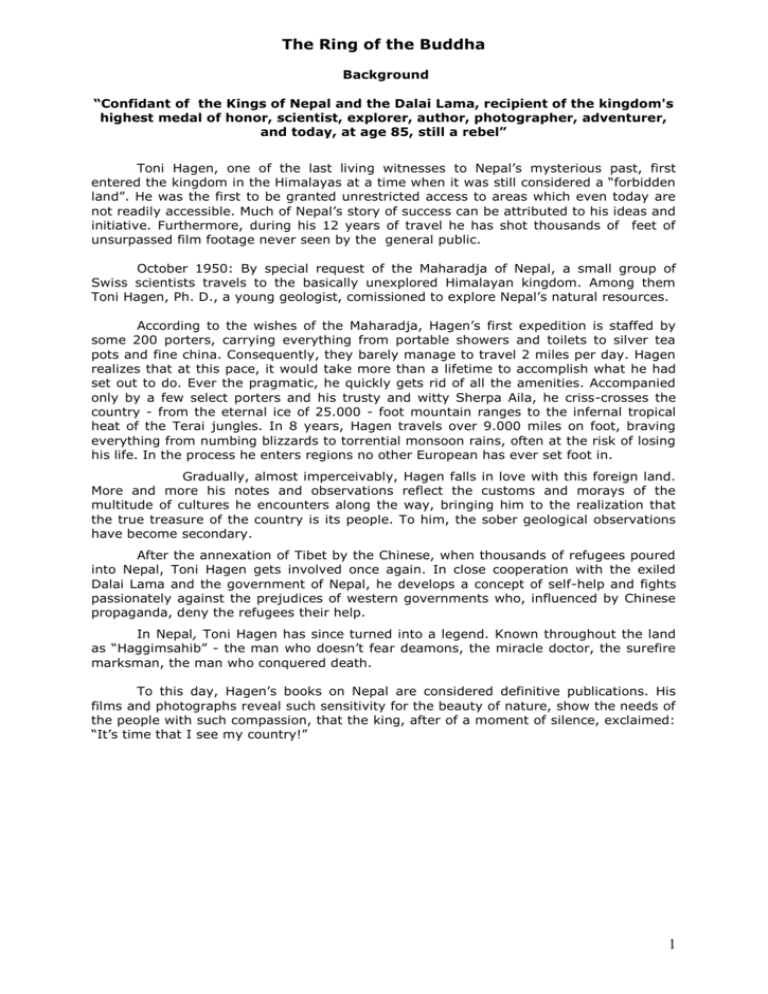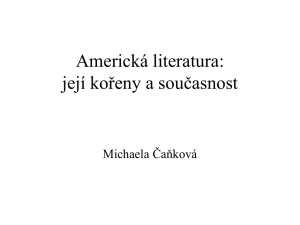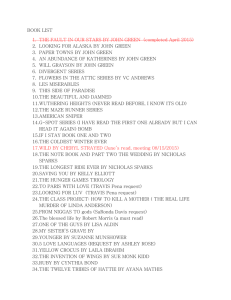
The Ring of the Buddha
Background
“Confidant of the Kings of Nepal and the Dalai Lama, recipient of the kingdom's
highest medal of honor, scientist, explorer, author, photographer, adventurer,
and today, at age 85, still a rebel”
Toni Hagen, one of the last living witnesses to Nepal’s mysterious past, first
entered the kingdom in the Himalayas at a time when it was still considered a “forbidden
land”. He was the first to be granted unrestricted access to areas which even today are
not readily accessible. Much of Nepal’s story of success can be attributed to his ideas and
initiative. Furthermore, during his 12 years of travel he has shot thousands of feet of
unsurpassed film footage never seen by the general public.
October 1950: By special request of the Maharadja of Nepal, a small group of
Swiss scientists travels to the basically unexplored Himalayan kingdom. Among them
Toni Hagen, Ph. D., a young geologist, comissioned to explore Nepal’s natural resources.
According to the wishes of the Maharadja, Hagen’s first expedition is staffed by
some 200 porters, carrying everything from portable showers and toilets to silver tea
pots and fine china. Consequently, they barely manage to travel 2 miles per day. Hagen
realizes that at this pace, it would take more than a lifetime to accomplish what he had
set out to do. Ever the pragmatic, he quickly gets rid of all the amenities. Accompanied
only by a few select porters and his trusty and witty Sherpa Aila, he criss-crosses the
country - from the eternal ice of 25.000 - foot mountain ranges to the infernal tropical
heat of the Terai jungles. In 8 years, Hagen travels over 9.000 miles on foot, braving
everything from numbing blizzards to torrential monsoon rains, often at the risk of losing
his life. In the process he enters regions no other European has ever set foot in.
Gradually, almost imperceivably, Hagen falls in love with this foreign land.
More and more his notes and observations reflect the customs and morays of the
multitude of cultures he encounters along the way, bringing him to the realization that
the true treasure of the country is its people. To him, the sober geological observations
have become secondary.
After the annexation of Tibet by the Chinese, when thousands of refugees poured
into Nepal, Toni Hagen gets involved once again. In close cooperation with the exiled
Dalai Lama and the government of Nepal, he develops a concept of self-help and fights
passionately against the prejudices of western governments who, influenced by Chinese
propaganda, deny the refugees their help.
In Nepal, Toni Hagen has since turned into a legend. Known throughout the land
as “Haggimsahib” - the man who doesn’t fear deamons, the miracle doctor, the surefire
marksman, the man who conquered death.
To this day, Hagen’s books on Nepal are considered definitive publications. His
films and photographs reveal such sensitivity for the beauty of nature, show the needs of
the people with such compassion, that the king, after of a moment of silence, exclaimed:
“It’s time that I see my country!”
1
The Ring of the Buddha
The Film
At age 82 Toni Hagen has lost nothing of his vitality and zest for life. He returns
to Nepal to accompany an old friend, the Buddhist monk Chogye Trichen Rimpoche, on
his last voyage. On his left hand Toni wears a precious ring, depicting a “Vajra”, the
sacred Tibetan thunderbolt. 40 years ago, the ring was presented to him by the
Rimpoche, an envoy and former teacher of the Dalai Lama, as a token of appreciation for
Hagen’s tireless commitment to the plight of Tibetan refugees. But Toni arrives too late.
The old monk and his entourage have already left the monastery and nobody seems to
know his final destination.
Hagen has arranged for a driver and travel companion. To Toni’s surprise, the
driver turns out to be a woman - an unusual sight, even by the standards of a modern
Nepali society. During their adventure-filled voyage through the Himalayan kingdom, the
charismatic young woman, Sarisvati, played eloquently by Indian actress Sonia Mehta,
initiates a lively exchange of experiences and opinions and presents her country from a
viewpoint rarely considered by Toni. In return, the man who has covered every square
inch of the land, makes “Sara” take a second look at things she always took for granted.
In flash-backs, triggered by Sarasvati’s inquisitiveness, we will return to the days
of young Toni’s adventuresome expeditions to the far corners of the land. Pristine color
motion picture film, shot by Toni during his early days in Nepal, lead into action-packed
dramatic sequences, showing Toni as the young scientist, explorer and adventurer,
portrayed with stunning likeness by the Tyrolian actor Martin Maria Abraham.
Finally, at a small Buddhist monastery high up in the Himalayas, Hagen does meet
upwith his friend, the Rimpoche. Toni pulls the ring from his finger and returns it to the
rightful owner. He no longer needs it. May it bring luck to someone else. The old monk
smiles: “My friend, you have kept your promise, the circle of our lives has closed.”
In the tail credits of the film, the Dalai Lama pays tribute to Toni’s tireless efforts
on behalf of all Tibetans –a great testimony to his friendship with this unique man.
©2001
all rights reserved
by
UDO GRUBE FILM
Stuttgart, Germany
2
The Ring of the Buddha
The Facts:
Format:
89 minutes, 35mm color digital blow-up
from super-16mm negative. Dolby
surround.
Genre:
Docu-drama with historical footage
Year completed:
2001
Locations:
Throughout Nepal
Original language:
Engish. German dub existing.
Music:
Original score, performed by
The Royal Philharmonic Orchestra
CAST:
Toni Hagen
Young Toni Hagen
Sarasvati Tapa
Dr. Toni Hagen himself
Martin Mariam Abram
Sonia Mehta
With the participation of:
HIS HOLINESS, THE DALAI LAMA
&
The late King of Nepal
HIS MAJESTY BIRENDRA BIR BIKRAM SHA DEV
Produced by:
Udo Grube
Directed by:
Jochen Breitenstein
* * *
3







